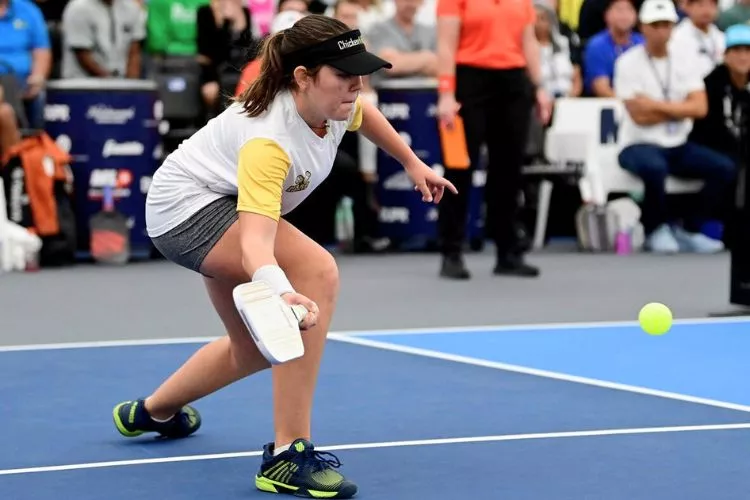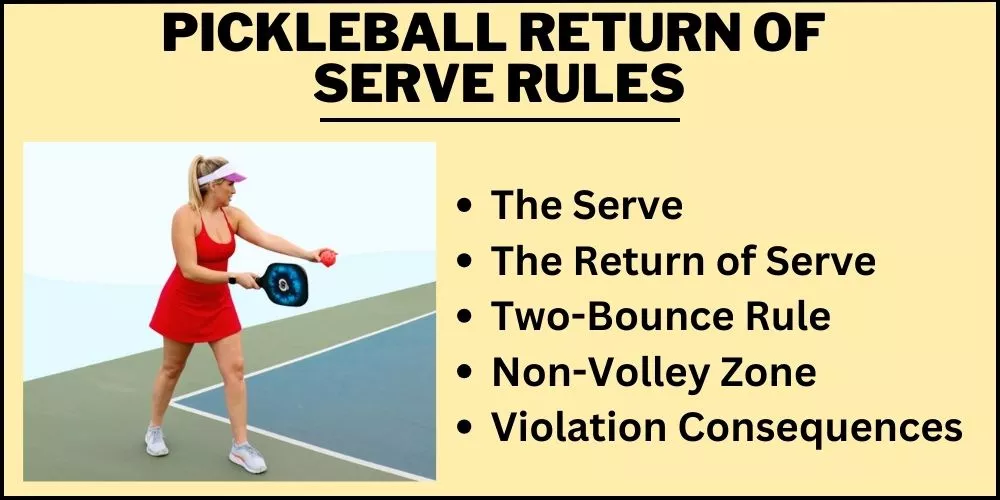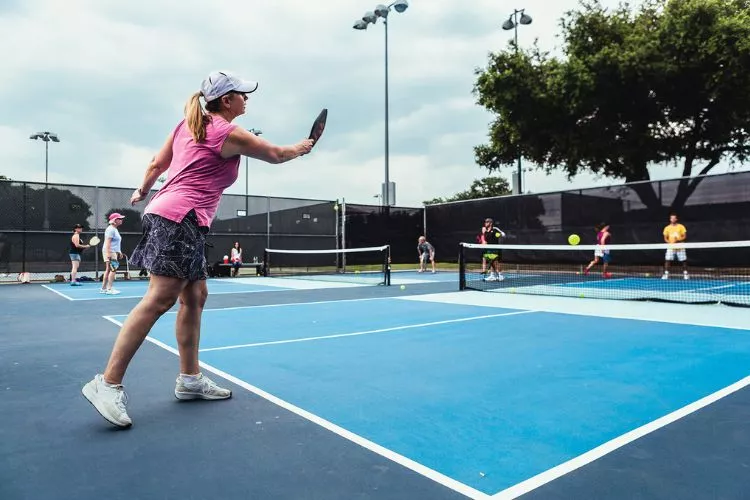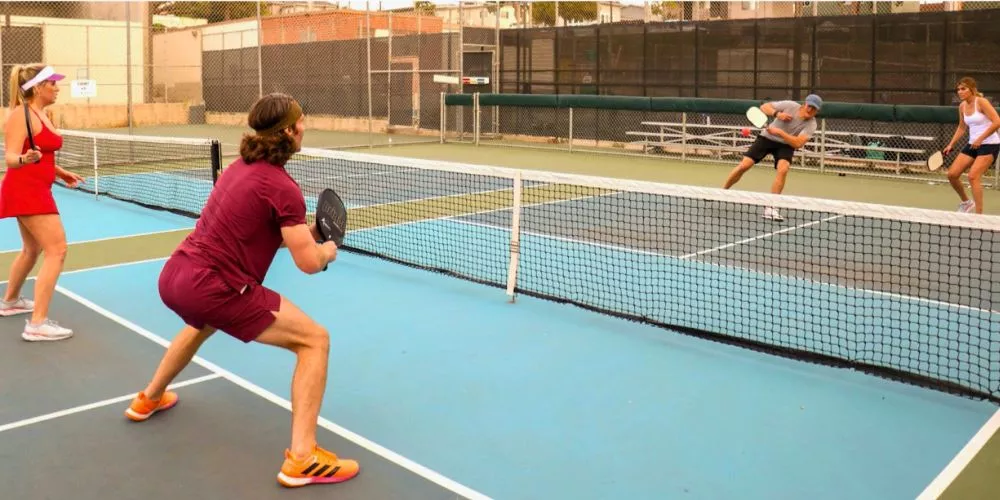As pickleball grows in popularity, understanding its rules becomes fundamental for enthusiasts and beginners alike.
A burning question many pickleball players frequently ask is: “Can either player return serve in pickleball?“
This article ventures into the depths of pickleball’s serving regulations, addressing the intricacies of this rule.

It examines if both players indeed have the capability to return the serve, or whether there are specific conditions they must meet.
Get ready to refine your knowledge of the serve return rule, amplifying your pickleball strategy on the court.
Can either player return serve in pickleball?
No, in pickleball, not just either player can return the serve. The rules explicitly denote that only the player on the opposite side from where the serve originated can return it.
For instance, if the serve comes from the right-hand serving area (even score), the return must be made by the opposing player in their right-hand court.
Conversely, if the serve is from the left (odd score), it should be returned from the left court of the opposing team.
Violating this rule results in a loss of a point for the servers in singles or a loss of serve in doubles.
The key to mastering pickleball strategy lies within understanding and leveraging these rules during gameplay.
Pickleball return of serve rules
Pickleball, an increasingly popular paddle sport, comes with a unique set of rules.
One such rule is the return of serve rule, which exhibits distinctive gameplay dynamics, diverging from what is typically found in similar racket sports like tennis or badminton.

1. The Serve
The serve in pickleball begins with an underhand motion, and must land diagonally across the court in the opponent’s serving area.
The server should serve from behind the baseline on alternating sides of their court with each point scored.
2. The Return of Serve
The pickleball rules strategically designate the player who can return the serve. It is not just any player who can return: the return of serve must come from the player diagonally opposite the server.
For example, if a serve is initiated from the right-hand court (server position is determined by the score – even scores mean the server serves from the right court), the return must be made by the receiver in the right-hand court of the opposing team.
If the serve comes from the left-hand court (with odd scores), the return should come from the opposing player in the left court.
3. Two-Bounce Rule
A crucial rule in pickleball, often also called the “two-bounce rule”, specifies that the ball must bounce once on each side before volleys (hitting the ball without bouncing) are allowed.
This means after the serve, you must let the return of serve bounce before hitting it.
4. Non-Volley Zone
The non-volley zone, also known as the “kitchen”, is a seven-foot area on both sides of the net. Players are not allowed to volley the ball while standing within this zone.
5. Violation Consequences
If the rules of return are violated, i.e., the wrong player returns the serve or the two-bounce rule is not followed, it results in a point for the server in singles. In doubles, it results in a loss of serve.
A comprehensive understanding of the return of serve rules dramatically influences a player’s strategy and proficiency in pickleball.
Striving to comprehend and apply these rules will undoubtedly enhance your performance in the game.
In pickleball can the return of serve land in the kitchen?
Yes, the return of serve in pickleball can land in the kitchen, as per the official pickleball rules.
Contrary to the serve, where the ball cannot land in the non-volley zone or the kitchen, the rules do not restrict the return of serve from landing in the kitchen.

When you return the serve, you must ensure that the ball first bounces in the proper service court (which includes the non-volley zone or kitchen) before you hit it.
Although there are no restrictions on the return of serve landing in the kitchen, it is generally not considered a good strategy to aim for the kitchen.
A short return can bring your opponents quicker to the kitchen and non-volley zone, providing them with an advantage unless they are relatively immobile.
Can your partner stand anywhere on the court while you are serving in pickleball?
No, your partner cannot stand just anywhere on the court while you are serving in pickleball. According to the rules of pickleball, positioning during serve is firmly stated.
When you are serving, your partner must be positioned on the court parallel to you but in the opposite service box.
This means that if you as a server are positioned in the right service box (for even points), your partner should be positioned in the left service box next to you.

To further clarify, if the serving team’s score is even (e.g., 0, 2, 4, 6, 8, 10), the player who was the first server in the game for that team will be in the right/even court when serving or receiving.
Conversely, when the score is odd (e.g., 1, 3, 5, 7, 9), that player will be in the left/odd court when serving.
Another thing to consider is visual distractions. The non-serving player should not behave in a way that creates a distraction when their partner is serving. In terms of positioning and behavior on the court, pickleball rules are designed to maintain a fair and orderly game environment.
Conclusion:
Understanding the rules of pickleball, specifically those concerning the return of serve, is essential for strategizing and achieving mastery in the game.
Only the player diagonally opposite to the server can return serves, adding a layer of required precision to the gameplay.
Surprisingly, returns are allowed to land anywhere, even the court’s non-volley zone, or ‘kitchen.’
By grasping these rules completely, players can enhance their pickleball proficiency, shaping their style to flourish within the sport’s unique constraints.
Every nuanced rule makes pickleball the exciting, inclusive, and strategic game that it is today.

Pickleball’s more than a game to me—it’s a passion. I write, sharing its highs and lows, the thrills and the lessons. Some tales might draw you to the court, while others give a hint of the game’s magic. So, curious about my journey? Ready to dive deep into the world of pickleball with me? Let’s go.
